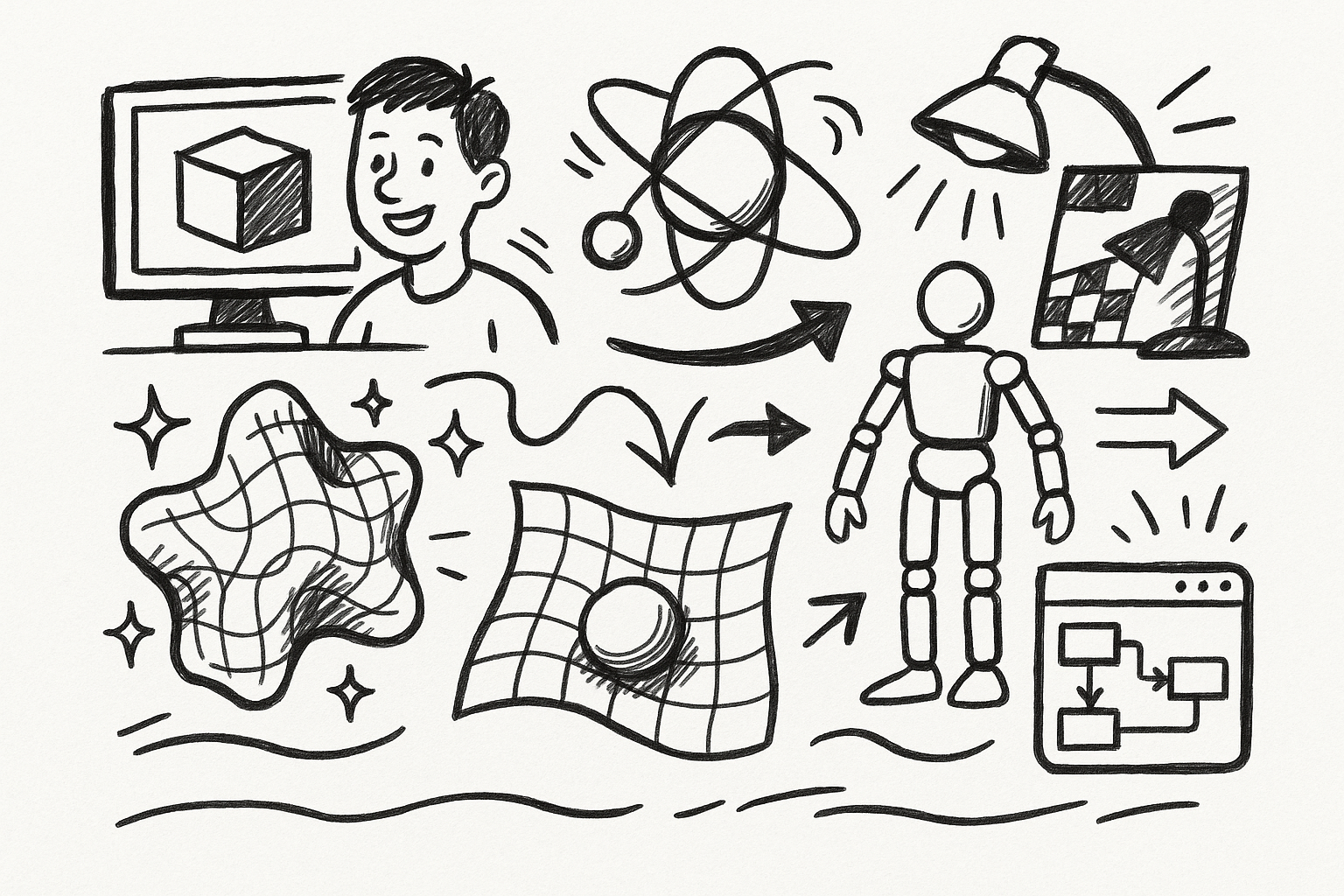Your Cart is Empty
Customer Testimonials
-
"Great customer service. The folks at Novedge were super helpful in navigating a somewhat complicated order including software upgrades and serial numbers in various stages of inactivity. They were friendly and helpful throughout the process.."
Ruben Ruckmark
"Quick & very helpful. We have been using Novedge for years and are very happy with their quick service when we need to make a purchase and excellent support resolving any issues."
Will Woodson
"Scott is the best. He reminds me about subscriptions dates, guides me in the correct direction for updates. He always responds promptly to me. He is literally the reason I continue to work with Novedge and will do so in the future."
Edward Mchugh
"Calvin Lok is “the man”. After my purchase of Sketchup 2021, he called me and provided step-by-step instructions to ease me through difficulties I was having with the setup of my new software."
Mike Borzage
Design Software History: Evolution of Design Software in Sustainable Landscape Architecture: Historical Perspectives and Future Innovations
July 18, 2025 8 min read


Introduction and Context
The evolution of sustainable landscape architecture has emerged as a truly compelling discipline that interweaves environmental stewardship with innovative design practices. Over the years, the integration of design software into environmental planning has not only revolutionized traditional landscape architecture methods but also provided a transformative platform for addressing the challenges posed by urban expansion, climate change, and resource scarcity. Sustainable landscape architecture, as a field, emerged from the fundamental need to harmonize natural ecosystems with human creativity, emphasizing the importance of ecological balance, renewable resources, and responsible land use. As a discipline, it has grown to incorporate complex data sets, simulation models, and interactive visualization tools designed to forecast environmental impacts and optimize resource distribution. This shift has been largely driven by global trends and key historical factors such as increasing public awareness of environmental issues, government policies promoting green initiatives, and the rapid technological advancements in computing power and software development.
Historical Influences and Technological Advances
In the early stages, the discipline was fueled by manual drafting techniques and hand-rendered blueprints, which, while artistically admirable, lacked the precision and analytical depth required to address sustainability challenges in fast-changing environments. With the advent of computer-aided design (CAD) systems during the latter part of the twentieth century, there was a seismic shift in landscape planning. This new era enabled professionals to incorporate critical environmental parameters such as soil quality, water resources, sunlight exposure, and existing flora and fauna into their projects. The incorporation of these factors marked the dawn of a more scientific, data-driven approach to landscape architecture whereby simulations could predict how natural systems would evolve over time amidst human intervention. In the same vein, pioneering companies and innovators began fostering collaborations that bridged the gap between traditional design and modern computing, thereby paving the way for new technologies that emphasized sustainability and resilience. Through bulleted lists, these early influences can be summarized as:
- Adoption of CAD systems to capture fine details with precision
- Integration of ecological datasets into the design process
- Early emphasis on environmental and sustainability metrics
- Collaborative efforts between technology developers and landscape architects
Historical Evolution of Design Software in Sustainable Landscape Architecture
Historically, the journey from manual drafting to sophisticated computer-aided design systems represents a monumental leap in how sustainable landscape architecture is practiced today. Initially, design professionals relied extensively on paper, mosquito ink, and manual computations to translate vision into reality, inherently limiting the scope of their environmental analyses. The introduction of CAD technology not only improved precision and efficiency but also allowed for the inclusion of multiple layers of environmental data into the design process. This early transition was marked by memory-intensive software that, despite its limitations, provided the groundwork for further innovative integrations such as Geographic Information Systems (GIS) and environmental modeling tools. During the late 20th century, companies such as Autodesk and Bentley Systems began to pioneer CAD systems capable of handling complex terrain, enabling architects to simulate water runoff, soil erosion, and other critical environmental parameters that directly impacted sustainability. These early developments signaled the beginning of a redefined design process that endeavored to optimize natural resource usage while simultaneously preserving the aesthetic narratives of natural landscapes.
Transition Milestones and Software Milestones
As innovations in software matured, there was a marked evolution toward incorporating ecological simulations into standard design workflows. Special interest was given to the integration of environmental simulation software, which allowed designers to predict how changes in weather patterns or soil composition could affect a project’s long-term viability. The emergence of dedicated simulation modules and environmental analysis tools within CAD platforms further underscored the industry’s commitment to sustainability. Influential pioneers like Ivan Sutherland, whose early work on interactive computer graphics revolutionized the concept of design automation, significantly contributed to the evolution of these technologies. Similarly, companies such as Esri championed the integration of GIS capabilities, enabling users to overlay ecological data with design schematics, thereby offering a multi-dimensional understanding of environmental relationships. The evolution of design software, therefore, was driven by several key milestones:
- The incorporation of digital mapping and surveying techniques
- Adoption of simulation models to test environmental scenarios
- Development of advanced computational tools that increased modeling accuracy
- Collaborative innovations that integrated ecological data into design frameworks
Key Innovations and Their Impact
In recent years, a series of groundbreaking innovations in design software have significantly reshaped the field of sustainable landscape architecture. One of the most vital shifts in this domain has been the incorporation of Geographic Information Systems (GIS) into design and planning workflows. GIS technology has empowered designers to capture, analyze, and visualize spatial data with unprecedented accuracy, thereby ensuring that every facet of the ecosystem is comprehensively represented in the design. This integration of spatial analysis tools has fostered a deeper understanding of macro-environmental trends such as water movement, soil composition, vegetation patterns, and microclimate variations. Furthermore, these advancements have been complemented by the rapid development of parametric modeling and simulation technologies, which offer designers the ability to iterate through a multitude of design alternatives while dynamically assessing the efficiency of energy consumption and resource usage. Such dedicated tools facilitate informed decision-making by quantifying performance metrics and forecasting long-term sustainability impacts, ultimately leading to more resilient and ecologically harmonious projects. The impact of these innovations is often underscored by the presence of several influential factors:
- Integration of GIS Technology – Providing dynamic spatial mapping and real-time analytical capabilities
- Advancements in Parametric Modeling – Allowing for adaptive design changes informed by environmental simulations
- Cloud Computing and Collaboration Platforms – Enabling seamless project collaboration and data sharing across vast geographical regions
- Enhanced Simulation Tools – Empowering designers to evaluate energy consumption, resource sustainability, and environmental impact in real time
Advancements in Cloud Computing and Simulation Technologies
The emergence of cloud-based platforms has further refined sustainable design practices by offering real-time insights into environmental dynamics and collaborative design engagements. Cloud computing facilitates the aggregation and analysis of large datasets, which are essential for capturing the inherently complex interactions present within natural systems. This approach allows landscape architects to access and process sophisticated data models without being constrained by local hardware limitations, thereby empowering them to evaluate environmental scenarios, simulate weather patterns, and optimize water resource management in a far more efficient manner. By integrating these simulation technologies with CAD and GIS platforms, design professionals are equipped with a level of precision that was previously unattainable. This evolution is marked by a confluence of advances:
- Real-time data sharing across global teams
- High-fidelity environmental simulations on scalable platforms
- Seamless integration of design, analysis, and visualization functions
- Enhanced cybersecurity measures to protect critical environmental data
Future Directions, Challenges, and Opportunities
As we move further into the digital age, the evolution of design software in sustainable landscape architecture is poised to take even bolder strides. The future holds exciting possibilities with the integration of emerging technologies such as augmented reality (AR) and virtual reality (VR) into the design process. These immersive tools have the potential to transform the way designers interact with their projects by offering realistic, three-dimensional visualizations of landscapes long before they are physically realized. The use of AR and VR is expected to further enhance the immersive experience of both designers and stakeholders, enabling them to virtually explore proposed green spaces and assess their environmental impact in an intuitive manner. In addition, the continuous drive toward better interoperability and standardization among various software tools is critical. This need is underscored by the fact that sustainable design is inherently data-driven and benefits significantly from seamless data integration across multiple platforms. By establishing robust protocols and globally recognized standards, industry professionals can ensure that ecological data, simulation results, and design schematics are consistently and accurately shared across diverse systems.
Addressing Regulatory and Environmental Challenges
However, with these technological advancements come a series of emerging challenges as well. The intricacies of environmental regulations continue to evolve as governments and international bodies push for greener policies and stricter compliance standards. This regulatory landscape exerts significant pressure on design software providers, who must continuously update their platforms to align with evolving guidelines. Furthermore, the exponential increase in data volume from various environmental sensors and simulations underscores the need for powerful, scalable computational infrastructures. The challenges ahead can be distilled into several core issues:
- Integration and standardization challenges across heterogeneous software systems
- The rapid pace of regulatory changes requiring continuous software adaptation
- Scalability issues associated with big data and high-resolution simulations
- Maintaining data integrity and cybersecurity in interconnected cloud platforms
Conclusion
The historical journey and technological evolution of design software in sustainable landscape architecture present an intriguing narrative of innovation, adaptation, and relentless pursuit of environmental excellence. Over the past few decades, the integration of computer-aided design, GIS, cloud computing, and simulation tools has not only enhanced the precision and scope of landscape planning but has also fundamentally redefined what it means to create spaces that are both functional and ecologically sustainable. The progression from traditional drafting methods to the use of sophisticated, data-driven software platforms has empowered designers to incorporate sustainability principles deeply into every aspect of their projects. These developments have enabled professionals to evaluate environmental impact, optimize resource utilization, and engage in forward-thinking planning that anticipates future ecological challenges.
Reflective Summary and Future Outlook
As we look ahead, it is clear that the convergence of emerging technologies—such as augmented reality, virtual reality, and big data analytics—with sustainable design paradigms will continue to push the boundaries of what is possible in landscape architecture. The challenges arising from evolving environmental regulations and the constant need for interoperability among design tools must be met with innovative solutions and collaborative efforts across industries. The lessons learned from the past have laid a solid foundation, illustrating that even the most complex design challenges can be met with ingenuity, rigorous analysis, and a commitment to ecological balance. Designers, developers, and environmental scientists alike stand to benefit from an ecosystem of digital tools that not only foster creativity but also rigorously address the practical demands of sustainability. With continued investment in research and development, the future of sustainable landscape architecture is poised to become even more integrative, resilient, and responsive to the needs of our ever-changing environment.
Also in Design News

Revolutionizing 3D Design: Exploring Five Groundbreaking Innovations in Cinema 4D
August 31, 2025 4 min read
Read More
Revolutionizing Telecommunications: The Rise of Advanced Design Software
August 31, 2025 16 min read
Read More
Cinema 4D Tip: Optimizing 2D Matte Integration with Projection Man in Cinema 4D
August 31, 2025 3 min read
Read MoreSubscribe
Sign up to get the latest on sales, new releases and more …


